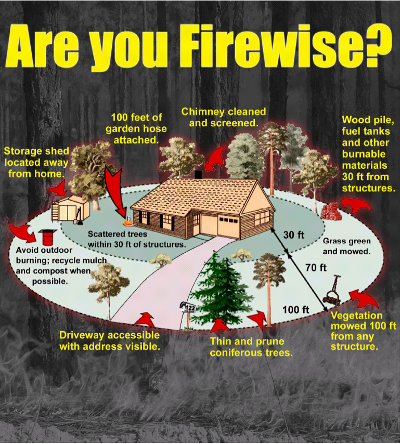
This article is part of a series in Summer 2012 in the pages of Green Source DFW covering landscaping and sustainable and organic gardening. For more see -
Tips on Organic Gardening in the Summer or
Advice on Making Composting Part of Your Gardening Plan
By Rita Cook
Wildfires are a threat to people and property across the Dallas/Fort Worth every summer. With massive fires once again plagueing western states and 4th of July festivities dampened by fears of wildfires, the issue is once again in

the news.
According to the Texas Forest Service, June is the most critical month in determining the severity of wildfire season in Texas. If the state receives rain then it is in good shape. If not, the likelihood of wildfires increases significantly.
(Wildfires are sweeping Western states, but many might be prevented by proper landscaping)
There are things that you can do to create a firewise landscape in order to reduce potential fuel if a fire should occur. By using fire-resistant plant materials strategically placed to lessen the chances of wildfire from damaging your home, Jim Ewoldsen, Certified Firewise Landscape with Collin County Master Gardeners says “Create a defensible space around your home, at least 30 feet around your building, structures and decks by using defensible space. Defensible space is the space between a structure and the Wildland area that, under normal conditions, creates a sufficient buffer to slow or halt the spread of wildfire to a structure. It protects the home from igniting due to direct flame or radiant heat too.”
Defensible space is essential for structure survivability during a wildfire and Ewoldsen points out a number of things that can be done to assure fire safety like the following:
- Remove all dead or dying vegetation;
- Trim tree canopies regularly to keep their branches a minimum of 10 feet from structures and other trees;
- Remove leaf litter (dry leaves, Pine needles) from yard, roof and rain gutters;
- Relocate woodpiles or other combustible materials away from structures;
- Remove combustible materials and vegetation from around and under decks;
- Remove or prune vegetation near windows
- Remove “ladder fuels” (low-level vegetation that allows the fire to spread from the ground to the tree canopy). Create a separation between low-level vegetation and tree branches. This can be done by reducing the height of low-level vegetation and/or trimming low tree branches.
“Most homes are set on fire from flying embers,” says Ewoldsen. “Roofs are the most vulnerable surface where embers land because they can lodge and start a fire.”
He also says that roof valleys, open ends of barrel tiles and rain gutters are all points of entry. Other ways a home can ignite is from direct flame contact and radiant heat. Keeping highly flammable plants and materials away from your home will not allow flames to stay long enough to ignite the home. Heat from a wildfire can cause windows to break even before the home ignites. This allows burning embers to enter and start internal fires. Single-paned and large windows are particularly vulnerable so instead, install dual-panned windows with the exterior pane of tempered glass to reduce the chance of breakage during a fire.
Stacie Durham, City of McKinney Fire Safety Coordinator says it’s also a good idea to be as educated as possible on fire safety this time of year.
“Summers in Texas are brutal and known for extreme heat and draught,” she says. “Educating ourselves on which types of plants to use and in what part of your landscape could mean the difference between having your home go up in flames, or not.”
She also adds that depending on the size of your property, you might even want to have up to 100-feet of space that is cleared and landscaped correctly.
“Also be sure you street address numbers are clearly visible so firefighters can find your house,” she concludes adding “Wildfires can happen at any time, dependent upon many factors. The 2011 Texas Wildfire season started in mid-November 2010 and officially ended on October 31, 2011. Texas’ longest wildfire season lasted from April 2005 through September 2006 a total of 18 months.”
Sign up for the weekly Green Source DFW Newsletter to stay up to date on everything green in North Texas, the latest news and events. Rita Cook is a freelance writer who has worked as a special Contributor to The Dallas Morning News and other major publications.









